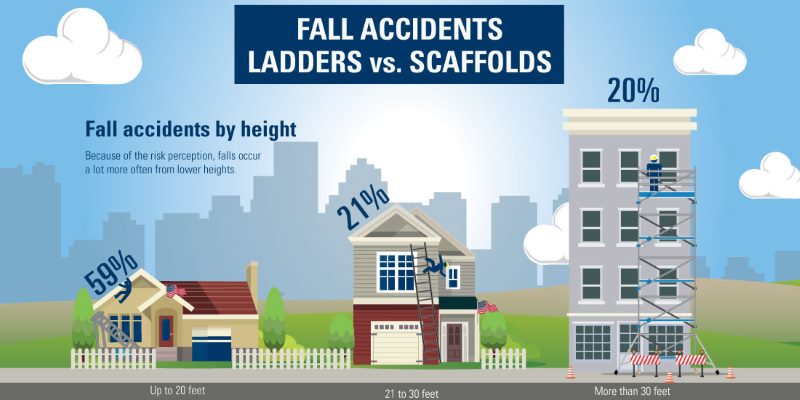
Skipping a step (ladder) towards safety
Every year, OSHA releases its Top 10 violations and citations. Last month at the National Safety Congress, they announced the new OSHA Top 10 for the fiscal year 2016. As you can see from the overview below, not much has changed in the ranking since the year before. However, one phenomenon always strikes us as peculiar….
1. Fall Protection 1926.501(c) 6,929 citations (+208 from 2015)
2. Hazard Communication 1910.1200 5,677 citations (+485 from 2015)
3. Scaffolds 1926.451(c) 3,906 citations (-389 from 2015)
4. Respiratory Protection 1910.134 3,585 citations (+280 from 2015)
5. Lockout/Tagout 1910.147 3,414 citations (+412 from 2015)
6. Powered Industrial Trucks 1910.178 2,860 citations (+100 from 2015)
7. Ladders 1926.1053(c) 2,639 citations (+150 from 2015)
8. Machine Guarding 1910.212 2,451 citations (+156 from 2015)
9. Electrical Wiring 1910.305 1,940 citations (-464 from 2015)
10. Electrical – General Requirements 1910.303 1,704 citations (-269 from 2015)
Scaffolding outranks ladders
Each year construction claims the life of more workers than any other industry in the United States. One-third of those construction fatalities are due to falls from height. Looking at the top 10, we see three standards that apply specifically to the construction industry: fall protection (#1), scaffolding (#3) and ladders (#7). It’s with the last two subjects that we see something odd.
For the past 5 years, scaffolding has always been responsible for more OSHA violations and citations than its work-at-height substitute: ladders. From 2012 until 2016, scaffold violations have ranked 3rd in the annual top 10. Ladder violations however, have moved up and down the list. In 2012 they ranked 5th, but in the years after that, they never ranked higher than 7th place. On average, scaffolding generates over 1,600 more violations each year than ladders.
Scaffolds ladders falls in construction

Is scaffolding more dangerous?
The numbers mentioned above might suggest that more risks are taken and hazards occur when using scaffolds, rather than with ladders. However, looking at the statistics for occupational injuries we see numbers contradicting this statement.
In 2011, CPWR, the Center for Construction Research and Training, released a report based on data from the Bureau of Labor Statistics (BLS). One of the chapters focuses on fatal and nonfatal injuries from falls in construction. Here, CPWR zooms in on the cause of these injuries. Between 2008 and 2010, 981 deaths were reported caused by falls in construction. In 24% of the cases a ladder was involved, whilst falls from scaffolds account for 15% of the fatalities. That’s near half of the number of fatal accidents caused by falls from ladders.
For nonfatal injuries, the difference is even bigger. In 2010, falls from height in construction were the cause of 18,130 nonfatal injuries that resulted in days away from work. Falls from ladders account for 23% of those accidents. Falls from scaffolding on the other hand, takes up just 4% of the total of 18,130 injuries in 2010.
So how come scaffolding receives far more citations each year suggesting more risks are being taken, while ladders are accountable for far more injuries both fatal and nonfatal?
In next following blog, we will further look into the differences between the two systems and come to a conclusion which one is safer in which situation.
